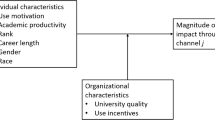Abstract
This study first presents a test of the Biglan model of faculty subcultures using measures of research output and then tests the model controlling for the effects of faculty socialization. Developed in 1973, the Biglan model categorizes academic subject areas into three dimensions: hard-soft, pure-applied, and life-nonlife. Although the model has been empirically validated seven times, only the present test using data from the 1977 Ladd and Lipset (1978) Survey of the American Professoriate examines the concept of socialization as an explanation for the differences among the groups. Using discriminant analyses, the Biglan model is found to be valid: the faculty in the hard area differed from the soft, the pure from the applied, and the life from the nonlife in terms of research output. In addition, the distinctiveness of the Biglan groups appear to increase with the socialization of faculty into subject areas. These results indicate that the model may be generalized to research and doctoral-granting institutions and that the concept of socialization warrants further examination as an explanation of differences among the Biglan groups.
Similar content being viewed by others
References
Bess, J. L. Anticipatory socialization of graduate students.Research in Higher Education 1978,3 289–317.
Becker, H. S. Student culture. InThe Study of Campus Cultures T. Lunsford (Ed.). Boulder, Col.: Western Interstate Commission for Higher Education, 1963, 11–26.
Biglan, A. The characteristics of subject matter in different academic areas.Journal of Applied Psychology 1973a,57 195–203.
Biglan, A. Relationships between subject matter characteristics and the structure and output of university departments.Journal of Appllied Psychology 1973b,57 204–213.
Blackburn, R. T., Charles E. Behymer and David E. Hall. Research note: correlates of faculty publications.Sociology of Education 1978,51 132–141.
Brim, O. G., Jr. Personality development as role learning. InPersonality Development in Children I. Iscoe and H. W. Stevenson (Eds.). Austin: University Texas Press, 1960.
Brim, O. G., Jr. and Wheeler, S.Socialization after childhood: two essays. New York: Wiley, 1966.
Carnegie Commission on Higher Education.A classification of institutions of higher education. Berkeley, Calif.: Carnegie Commission on Higher Education, 1973.
Clark, B. R. Faculty culture. InThe Study of Campus Cultures Terry Lunsford (Ed.). Boulder, Col.: Western Interstate Commission for Higher Education, 1963, 39–54.
Cole S., and Cole, J. R. Scientific output and recognition: a study in the operation of the reward system in science.American Sociological Review 1967,32 377–390.
Creswell, J. W., Seagren, A. T. and Henry, T. C. Professional development training needs of department chairperson: a test of the Biglan model.Planning and Changing 1980,10 224–237.
Edison, C. L. The measurement of satisfaction in departmental association at Western Kentucky University testing the Holland and Biglan Models, Ed.D. Dissertation, University of Kentucky, 1976.
Hersey, P. and Blanchard, K.Management of organizational behavior. Englewood Cliffs, N.J.: Prentice-Hall, 1972.
Kuhns, T. S.The structure of scientific revolutions. Chicago: University of Chicago Press, 1970.
Ladd, E. C. Jr., and Lipset, S. M. Technical report, 1977 survey of the American professoriate. Social Science Data Center, University of Connecticut, 1978.
Light, D. W. The structure of the academic profession.Sociology of Education 1974,47 2–28.
Lodahl, J. B., and Gordon, G. The structure of scientific fields and the functioning of university graduate departments.American Sociological Review 1972,37 57–72.
Menzel, H. Planned and unplanned scientific communication. InThe Sociology of Sciences B. Barber and W. Hirsch (Eds.). New York: Free Press, 1962.
Morrison, D. G. On the interpretation of discriminant analysis.Journal of Marketing Research 1969,6 156–63.
Muffo, J. A., and Langston, I. W.An empirical model for the use of Biglan's disciplinary categories. Unpublished manuscript. Champaign, Ill.: Office of Administrative Studies, April 1979.
Neumann, Y. and Boris, S. B. Paradigm development and leadership style of university department chairpersons.Research in Higher Education 1978,9 291–302.
Pace, C. R. Interactions among academic, administrative, and student subcultures. InThe Study of Campus Cultures Terry Lunsford (Ed.). Boulder, Col: Western Interstate Commission for Higher Education, 1963, 55–80.
Sarbin, T. R. Role theory. InThe Handbook of Social Psychology G. Lindzey and E. Aronson (Eds.) (2nd edition). Reading, Mass: Addison-Wesley, 1968.
Smart, J. C. and Elton, C. F. Administrative roles of department chairmen. InExamining Departmental Management John C. Smart and James R. Montgomery (Eds.). New Directions for Institutional Research. San Francisco: Jossey-Bass, Inc., 1976, 39–60.
Smart, J. C. and Elton, C. F. Goal orientation of academic departments: a test of Biglan's model.Journal of Applied Psychology 1975,60 580–588.
Smart, J. C. and McLaughlin, G. W. Reward structures of academic disciplines.Research in Higher Education 1978,8 39–55.
Snow, C. P.The two cultures and the scientific revolution. London: Cambridge University Press, 1959.
Stern, G. C.People in context. New York: Wiley 1970.
Tatsuoka, M. M.Multivariate analysis: techniques for educational and psychological research. London: Wiley, 1971.
Thompson, M. E., and Brewster, D. A. Faculty behavior in low-paradigm versus high paradigm disciplines: a case study.Research in Higher Education 1978,8 169–175.
Author information
Authors and Affiliations
Rights and permissions
About this article
Cite this article
Creswell, J.W., Bean, J.P. Research output, socialization, and the biglan model. Res High Educ 15, 69–91 (1981). https://doi.org/10.1007/BF00976549
Received:
Issue Date:
DOI: https://doi.org/10.1007/BF00976549




